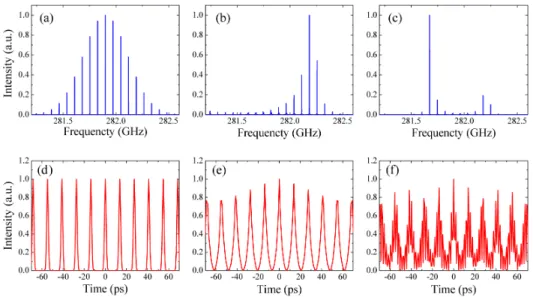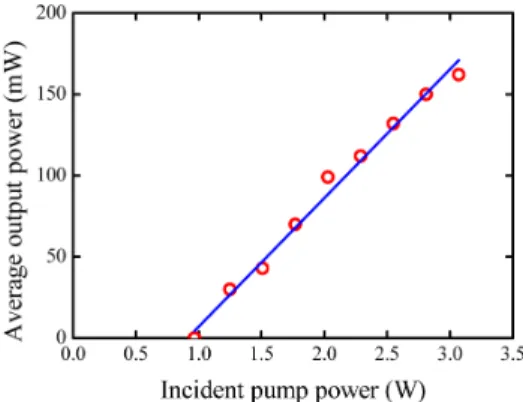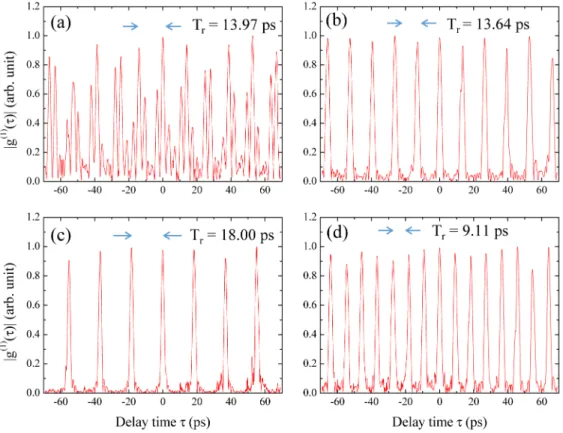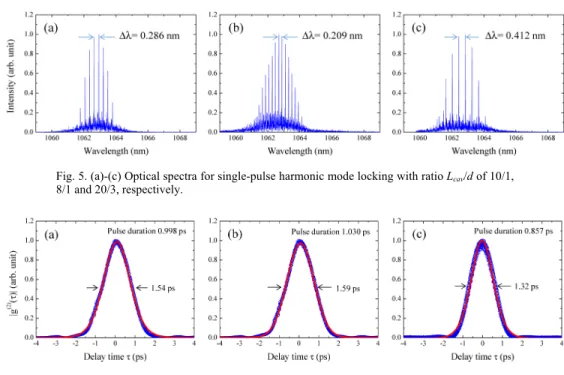Theoretical and experimental studies for
high-repetition-rate disordered crystal lasers with
harmonic self-mode locking
C. L. Sung,1 C. Y. Lee,1 H. H. Cho,1 Y. J. Huang,1 Y. F. Chen,1,2,* Z. B. Pan,3 H. H. Yu,3 H. J. Zhang,3 and J. Y. Wang3
1Department of Electrophysics, National Chiao Tung University, Hsinchu, Taiwan 2Department of Electronics Engineering, National Chiao Tung University, Hsinchu, Taiwan
3State Key Laboratory of Crystal Materials and Institute of Crystal Materials, Shandong University, Jinan, China *yfchen@cc.nctu.edu.tw
Abstract: A harmonically self-mode-locked Nd:Sr3Y2(BO3)4 disordered
crystal laser with subpicosecond pulse duration is demonstrated. We exploit the damped harmonic oscillator model to numerically verify that the mode spacing of the laser cavity can be modified to be the harmonics of the free spectral range of the Fabry-Perot cavity when the optical length of the laser cavity is close to a commensurate ratio of the optical length of the Fabry-Perot cavity. In experiment, the Fabry-Fabry-Perot cavity can be formed by the pump facet of the disordered crystal and the front mirror. A 110 GHz single-pulse harmonically mode-locked pulse train with pulse duration of 857 fs is experimentally achieved under optical lengths of 27.19 and 4.08 mm for the laser cavity and Fabry-Perot cavity respectively, corresponding to a fractional number of 20/3. A maximum output power of 162 mW is obtained at an incident pump power of 3.1 W.
©2016 Optical Society of America
OCIS codes: (140.3480) Lasers, diode-pumped; (140.3580) Lasers, solid-state; (140.4050)
Mode-locked lasers.
References and links
1. T. Tomaru and H. Petek, “Femtosecond Cr4+:YAG laser with an L-fold cavity operating at a 1.2-GHz repetition
rate,” Opt. Lett. 25(8), 584–586 (2000).
2. C. Silberhorn, P. K. Lam, O. Weiss, F. König, N. Korolkova, and G. Leuchs, “Generation of Continuous Variable Einstein-Podolsky-Rosen Entanglement via the Kerr Nonlinearity in an Optical Fiber,” Phys. Rev. Lett.
86(19), 4267–4270 (2001).
3. J. Federici and L. Moeller, “Review of terahertz and subterahertz wireless communications,” J. Appl. Phys.
107(11), 111101 (2010).
4. Y. Sun, J. Q. Pan, L. J. Zhao, W. X. Chen, W. Wang, L. Wang, X. F. Zhao, and C. Y. Lou, “All-optical clock recovery for 20 Gb/s using an amplified feedback DFB Laser,” J. Lightwave Technol. 28(17), 2521–2525 (2010).
5. D. A. B. Miller, “Optics for low-energy communication inside digital processors: quantum detectors, sources, and modulators as efficient impedance converters,” Opt. Lett. 14(2), 146–148 (1989).
6. A. Bartels, T. Dekorsy, and H. Kurz, “Femtosecond Ti:sapphire ring laser with a 2-GHz repetition rate and its application in time-resolved spectroscopy,” Opt. Lett. 24(14), 996–998 (1999).
7. H. Hu, H. C. H. Mulvad, C. Peucheret, M. Galili, A. Clausen, P. Jeppesen, and L. K. Oxenløwe, “10 GHz pulse source for 640 Gbit/s OTDM based on phase modulator and self-phase modulation,” Opt. Express 19(26), B343– B349 (2011).
8. J. Schröder, S. Coen, F. Vanholsbeeck, and T. Sylvestre, “Passively mode-locked Raman fiber laser with 100 GHz repetition rate,” Opt. Lett. 31(23), 3489–3491 (2006).
9. K. Sato, “Optical pulse generation using Fabry-Perot lasers under continuous-wave operation,” IEEE J. Sel. Top. Quantum Electron. 9(5), 1288–1293 (2003).
10. C. Gosset, K. Merghem, A. Martinez, G. Moreau, G. Patriarche, G. Aubin, A. Ramdane, J. Landreau, and F. Lelarge, “Subpicosecond pulse generation at 134 GHz using a quantum-dash-based Fabry-Perot laser emitting at 1.56 μm,” Appl. Phys. Lett. 88(24), 241105 (2006).
11. P. Klopp, U. Griebner, M. Zorn, and M. Weyers, “Pulse repetition rate up to 92 GHz or pulse duration shorter than 110 fs from a mode-locked semiconductor disk laser,” Appl. Phys. Lett. 98(7), 071103 (2011).
12. T. W. Wu, C. H. Tsou, C. Y. Tang, H. C. Liang, and Y. F. Chen, “A high-power harmonically self-mode-locked Nd:YVO4 1.34-μm laser with repetition rate up to 32.1 GHz,” Laser Phys. 24(4), 045803 (2014).
13. M. N. Kong, J. K. Chee, and J. M. Liu, “Passive mode locking with a nonlinear external coupled cavity at high pulse repetition rates,” Opt. Lett. 16(2), 73–75 (1991).
14. Y. F. Chen, W. Z. Zhuang, H. C. Liang, G. W. Huang, and K. W. Su, “High-power subpicosecond harmonically mode-locked Yb:YAG laser with pulse repetition rate up to 240 GHz,” Laser Phys. Lett. 10, 1 (2012). 15. W. Z. Zhuang, M. T. Chang, K. W. Su, K. F. Huang, and Y. F. Chen, “High-power terahertz optical pulse
generation with a dual-wavelength harmonically mode-locked Yb:YAG laser,” Laser Phys. 23(7), 075803 (2013).
16. G. Q. Xie, D. Y. Tang, W. D. Tan, H. Luo, S. Y. Guo, H. H. Yu, and H. J. Zhang, “Diode-pumped passively mode-locked Nd:CTGG disordered crystal laser,” Appl. Phys. B 95(4), 691–695 (2009).
17. G. Q. Xie, D. Y. Tang, W. D. Tan, H. Luo, H. J. Zhang, H. H. Yu, and J. Y. Wang, “Subpicosecond pulse generation from a Nd:CLNGG disordered crystal laser,” Opt. Lett. 34(1), 103–105 (2009).
18. J. Ma, G. Q. Xie, W. L. Gao, P. Yuan, L. J. Qian, H. H. Yu, H. J. Zhang, and J. Y. Wang, “Diode-pumped mode-locked femtosecond Tm:CLNGG disordered crystal laser,” Opt. Lett. 37(8), 1376–1378 (2012).
19. J. Liu, Z. Wang, K. He, L. Wei, Z. Zhang, Z. Wei, H. Yu, H. Zhang, and J. Wang, “Passively mode-locked femtosecond laser with an Nd-doped La3Ga5SiO14 disordered crystal,” Opt. Express 22(22), 26933–26938
(2014).
20. Y. B. Li, Z. T. Jia, Y. Yang, X. W. Fu, D. S. Yuan, Y. C. Zhi, C. M. Dong, B. T. Zhang, J. L. He, and X. T. Tao, “Diode-end-pumped passively mode-locked Nd:GAGG laser at 1.3 μm with SESAM,” Laser Phys. Lett. 9(8), 557–560 (2012).
21. H. Luo, D. Y. Tang, G. Q. Xie, W. D. Tan, H. J. Zhang, and H. H. Yu, “Diode-pumped passively mode-locked Nd:CLNGG laser,” Opt. Commun. 282(2), 291–293 (2009).
22. B. Y. Zhang, J. L. Xu, G. J. Wang, J. L. He, W. J. Wang, Q. L. Zhang, D. L. Sun, J. Q. Luo, and S. T. Yin, “Diode-pumped passively mode-locked Nd:GYSGG laser,” Laser Phys. Lett. 8(11), 787–790 (2011). 23. Y. F. Chen, H. C. Liang, J. C. Tung, K. W. Su, Y. Y. Zhang, H. J. Zhang, H. H. Yu, and J. Y. Wang,
“Spontaneous subpicosecond pulse formation with pulse repetition rate of 80 GHz in a diode-pumped Nd:SrGdGa3O7 disordered crystal laser,” Opt. Lett. 37(4), 461–463 (2012).
24. Z. B. Pan, H. J. Cong, H. H. Yu, H. J. Zhang, J. Y. Wang, and R. I. Boughton, “Growth, morphology and anisotropic thermal properties of Nd-doped Sr3Y2(BO3)4 crystal,” J. Cryst. Growth 363, 176–184 (2013).
25. F. Krausz, T. Brabec, and C. Spielmann, “Self-starting passive mode locking,” Opt. Lett. 16(4), 235–237 (1991). 26. H. Yu, H. Zhang, Z. Wang, J. Wang, Y. Yu, Z. Shi, X. Zhang, and M. Jiang, “Continuous-wave and passively Q-switched laser performance with a disordered Nd:CLNGG crystal,” Opt. Express 17(21), 19015–19020 (2009). 27. Z. Pan, H. Yu, H. Cong, H. Zhang, J. Wang, Q. Wang, Z. Wei, Z. Zhang, and R. I. Boughton, “Polarized spectral
properties and laser demonstration of Nd-doped Sr3Y2(BO3)4 crystal,” Appl. Opt. 51(30), 7144–7149 (2012).
1. Introduction
Light sources with high repetition rates are scientific interest for many potential applications, such as telecommunication, optical clocking, photonic switching, high signal-to-noise ratio measurements, and high capacity optical networks [1–7]. Many approaches have been developed to achieve high repetition rates, including harmonically mode-locked fiber lasers, quantum-well Fabry-Perot lasers, quantum-dash-based Fabry-Perot mode-locked lasers, and passively mode-locked solid-state lasers [8–11]. Among these methods, harmonic mode locking is a promising approach with the advantages of compactness and low cavity losses. In the past few years, harmonically mode-locked operation has been explored in numerous traditional solid-state lasers, such as Nd:YVO4 lasers, Nd:YLF lasers, and Yb:YAG lasers
[12–15].
Compared to conventional laser crystals, disordered crystals possess the random distribution of cations in the host material to lead to the large inhomogeneous spectral broadening [16]. The broader emission spectra are beneficial for generating shorter mode-locked pulse [17]. On the other hand, disordered crystals can be more insensitive to the pump wavelength than conventional laser crystals in the diode pumping scheme owing to the broad absorption spectra [18]. Furthermore, disordered crystals usually have the positive coefficient of the variation of thermal conductivity on temperature that is useful in balancing the thermal effects for power scale up [19]. Nowadays, various disordered crystals, such as Nd:GAGG, Nd:CLNGG, and Nd:GYSGG, have been employed to achieve passively mode-locked lasers with a semiconductor saturable absorber mirror [20–22]. Nevertheless, harmonically self-mode-locked lasers with disordered crystals as the gain medium are seldom explored [23].
Nd:Sr3Y2(BO3)4 disordered crystal belongs to the orthorhombic system [24] which
possesses much broader emission spectrum than those belong to the cubic (Nd:GAGG, Nd:CLNGG, and Nd:GYSGG) or tetragonal (Nd:SGGM) system. In this work, we utilize a Nd:Sr3Y2(BO3)4 disordered crystal as the gain medium to generate a harmonically
self-mode-locked laser at high repetition rate together with ultrashort pulse. First of all, we numerically show that when the ratio of the optical length of the laser cavity to the optical length of the Fabry-Perot cavity, denoted as q/p, is exactly close to a fraction number, the temporal trace will display single-pulse harmonic mode locking. In the experiment, we can realize the harmonically mode-locked lasing output once the optical cavity length Lcav and the separation
d between the gain medium and the front mirror satisfy a commensurate ratio. A 110 GHz
pulse train with pulse duration as short as 857 fs is obtained at an optical cavity length Lcav of
27.19 mm and a separation d of 4.08 mm, corresponding to a fractional number of 20/3. At an incident pump power of 3.1 W, an average output power of 162 mW is achieved, corresponding to a slope efficiency of 7.9%. To the best of our knowledge, it is the highest repetition rate ever obtained in disordered crystal lasers and the first report for Nd:Sr3Y2(BO3)4 disordered crystal laser manipulated in the harmonically self-mode-locked
operation.
2. Theoretical analysis
The evolution of laser oscillation from the free-running state toward the steady-state mode-locked operation was firstly investigated by F. Krausz et al. [25]. The condition for self-starting mode locking can be expressed as
1 ln( ) r i c T P m T κ > (1)
where κ is a characteristic of the Kerr nonlinearity, Pi is the circulating intracavity power in
the free-running laser, Tr is the cavity round-trip time, and Tc is a finite correlation time
concerning axial modes oscillating in the free-running laser. Referring to Eq. (1), a shorter Tr
is more beneficial to the self-starting mode locking. The effective round-trip time for n-th order harmonic mode locking can be reduced n times. Therefore, high-order harmonic mode locking may be more useful for the self-starting mode locking. Next, we theoretically analyze the condition for achieving the harmonically mode-locked operation.
The frequency spectrum of the phase-locked longitudinal modes in the laser cavity can be described by the damped harmonic oscillator model and given by
[
]
2 2 2 ( / ) 0 2 2 2 2 0 0 ( ) ( ) ( ) ( ) ( ) c m M f c m M c c f f I f e f f m f f f γ γ − Γ Δ =− − = − − Δ + −
(2)where f0 is the center frequency, Δfc is the mode spacing of longitudinal modes, γc is the
damping constant for the laser cavity, and Γ is the linewidth of the gain profile. Here, we presume the distribution of longitudinal modes to be Gaussian-shaped. Provided that the front mirror and the pump surface of the laser crystal form a Fabry-Perot cavity, the resultant frequency spectrum of the laser emission is modulated with an effective transmission function:
[
]
[
]
2 2 2 ( / ) 0 2 2 2 2 0 0 2 0 2 2 2 2 0 0 ( ) ( ) ( ) ( ) ( ) ( ) ( ) ( ) ( ) c m M f c m M c c N FP n N FP FP f f I f e f f m f f f f f f f n f f f γ γ γ γ − Γ Δ =− =− − = − − Δ + − − × − − Δ + −
(3)where γFP and ΔfFP are the damping constant and mode spacing for the Fabry-Perot cavity,
respectively. Note that ΔfFP can be rewritten as qΔfc/p, where q/p is the ratio of the optical
length of the laser cavity to the optical length of the Fabry-Perot cavity. Figure 1(a)-1(c) demonstrate the frequency spectra of the laser output for q/p = 10/1, 10/1.015, and 10/1.075
with the following parameters: f0 = 282.2 GHz, Δfc = 7.3 GHz, γc = 0.01, γg = 0.1, Γ = 592.3
GHz, M = 100, N = 10. The temporal forms of the laser output corresponding to Fig. 1(a)-(c) can be obtained by Fourier transforming Eq. (3) as shown in Fig. 1(d)-1(f). When the ratio q/p is precisely close to the fractional number of 10/1, we can see it obviously that the frequency spectrum exhibits a well Gaussian profile as illustrated in Fig. 1(a). In the meanwhile, the laser output shows good harmonic mode locking with tenth order as demonstrated in Fig. 1(d). With slightly deviating the numerator p from 1 to 1.015, the profile of the frequency spectrum can still be Gaussian-shaped with center frequency shifted, as referring to Fig. 1(b). For the temporal structure shown in Fig. 1(e), the pulse train can still maintain to be 10-th harmonic mode locking except for some amplitude fluctuation. However, when the numerator
p is much deviated from 1 to 1.075, no Gaussian shape is observed in the frequency spectrum
and the temporal trace displays a multi-pulse mode-locked operation, as depicted in Fig. 1(c) and 1(f). According to the numerical results, we can find out that the optical length of the laser cavity must be very close to the commensurate ratio of the optical length of the Fabry-Perot cavity for achieving a good harmonically mode-locked pulse train.
Fig. 1. (a)-(c) Numerical results for the frequency spectrum with three different fraction numbers q/p of 10/1, 10/1.015, and 10/1.075, respectively. (d)-(f) Temporal structures corresponding to the Fourier transformation of the frequency spectrum shown in (a)-(c), respectively.
3. Experimental setup
The experimental setup for the harmonically self-mode-locked Nd:Sr3Y2(BO3)4 disordered
crystal laser with a concave-plano resonator is shown in Fig. 2(a). The Nd:Sr3Y2(BO3)4
disordered crystal was cut along the b axis with a Nd3+ concentration of 0.685 at.% and a
dimension of 3 mm × 3 mm in cross section and 8 mm in length. Both end surfaces were coated for antireflection at the pump wavelength of 808 nm and the lasing wavelength of 1064 nm. Figure 2(b) shows the fluorescence spectrum of the Nd:Sr3Y2(BO3)4 disordered
crystal in the 4F
3/2→4I11/2 transition at room temperature. The luminescence bandwidth can be
seen to be nearly 25 nm which is wider than those of Nd:GAGG (4 nm) [21], Nd:CLNGG (16.5 nm) [26], and Nd:GYSGG (4.95 nm) [22] disordered crystals. The luminescence lifetime is 75.8 μs at room temperature [27]. To ensure the laser working in the stable operation, the disordered crystal was wrapped with indium foil and mounted in a water-cooled copper block with circulating water maintained at 16 °C. The front mirror was an 100-mm-radius-of-curvature concave mirror with high-reflectance coating at 1064 nm (>99.8%). A flat wedged output coupler with 98% reflection at 1064 nm was utilized in the experiment.
The pump source was a 3-W 808-nm fiber-coupled laser diode with a core diameter of 100 μm and a NA of 0.16. A pair of identical plano-convex focusing lenses with 25-mm focal length and 85% coupling efficiency was used to reimage the pump beam into the laser crystal. The average pump diameter was approximately 120 μm.
Since the pulse repetition rate in our experiment was higher than the bandwidth limit for both digital oscilloscope (20 GHz) and RF power spectrum analyzer (26 GHz), no peaks were observed in the digital oscilloscope or RF power spectrum analyzer. The temporal behavior of the laser output was studied with the help of the first- and second-order autocorrelations. The first-order autocorrelation trace was monitored by a Michelson interferometer (Advantest, Q8347). It was also capable of performing optical spectral analysis by Fourier transforming the first-order field autocorrelation with a resolution of 0.003 nm. The second-order autocorrelation trace was recorded with a commercial autocorrelator (APE pulse check, Angewandte Physic & Elektronik GmbH) for performing the profile of the single mode-locked pulse.
Fig. 2. (a) Experimental setup for a harmonically self-mode-locked Nd:Sr3Y2(BO3)4 disordered
crystal laser. (b) Fluorescence spectrum of the Nd:Sr3Y2(BO3)4 disordered crystal at room
temperature.
4. Experimental results and discussion
First of all, we measured the output performance of the laser system. The experimental result for the average output power as a function of the incident pump power is shown in Fig. 3. At an incident pump power of 3.1 W, an average output power of 162 mW was experimentally obtained, corresponding to a slope efficiency of approximately 7.9%. Next, we adjusted the ratio of the optical cavity length Lcav to the separation d between the front mirror and the laser
crystal to investigate the temporal behavior under an incident pump power of 2.4 W. Experimental results reveal that when the pump power is slightly above the threshold (> 1 W), the self-mode-locked performance is almost the same for all the investigated pump powers. Only when the pump power is near to the threshold power (between 0.98 and 1 W), the harmonically self-mode-locking is difficult to obtain.
At first, we set the optical cavity length Lcav and separation d to be 21.32 and 2.24 mm,
respectively. Under this condition, the ratio Lcav/d can be calculated to be slightly deviated
from a simple fractional number of 10/1. Therefore, the laser output displayed a multi-pulse mode-locked operation at repetition rate of approximately 70 GHz as revealed in Fig. 4(a). After finely adjusting the optical cavity length Lcav to be precisely close to the commensurate
ratio of the separation d, the single-pulse mode locking with a pulse separation of 13.64 ps could be achieved as depicted in Fig. 4(b). In this case, the optical cavity length Lcav and
separation d were 21.47 and 2.14 mm, respectively. We can find out that the ratio Lcav/d was
quite close to the fractional number of 10/1. By scanning the optical cavity length from 20 to 30 mm while suitably tuning the separation d, single-pulse harmonic mode locking with different orders could be experimentally observed. Figure 4(c) and 4(d) demonstrate pulse trains of the single-pulse harmonic mode locking with pulse separation of 18.28 and 9.11 ps, corresponding to the repetition rate of 50 and 110 GHz respectively. The optical cavity length
Lcav and separation d are 21.63 and 2.10 mm for Fig. 4(c), and 27.19 and 4.08 mm for Fig.
4(d), respectively. The ratio Lcav/d can be found to be close to fraction numbers of 8/1 and
20/3. The fluctuations of the measured harmonically mode-locked single-pulse train are all better than 5%.
Fig. 4. Experimental traces of the first-order autocorrelations for the operation of three cases of harmonic mode locking: (a) the trace for the multiple-pulse mode locking with repetition rate of 70 GHz; (b) the trace for the single-pulse mode locking with repetition rate of 70 GHz; (c) the trace for the single-pulse mode locking with repetition rate of 55 GHz; (d) the trace for the single-pulse mode locking with repetition rate of 110 GHz.
The optical spectra corresponding to the single-pulse mode locking for the ratios Lcav/d =
10/1, 8/1, and 20/3 are shown in Fig. 5. The mode spacing was found to be approximately 0.286, 0.209, and 0.412 nm, which was consistent with the pulse repetition rate of 70, 55, and 110 GHz as shown in Fig. 4(b)-4(d), respectively. Additionally, we can see that the envelopes of the lasing spectrum display a Gaussian shape. These results reveal that the ratios Lcav/d are
precisely close to a fractional number as we discussed in the section of the theoretical analysis. On the other hand, the second-order autocorrelation traces for Lcav/d = 10/1, 8/1, and
20/3 are demonstrated in Fig. 6. The full width at half maximum of a mod-locked pulse was approximately 1.54, 1.59, and 1.32 ps for Lcav/d = 10/1, 8/1, and 20/3, respectively. Assuming
the temporal intensity to be the sech2 profile, the pulse durations were found to be 0.998,
1.03, and, 0.857 ps, respectively. The time-bandwidth product was calculated to be 0.357, 0.332, and 0.419, which was 1.13, 1.05 and 1.33 times of the Fourier transform limit value for the sech2-shaped pulses. The present results recommend the Nd:Sr
3Y2(BO3)4 disordered
crystal as a promising gain medium for generating high repetition rate with ultrashort pulse duration.
Fig. 5. (a)-(c) Optical spectra for single-pulse harmonic mode locking with ratio Lcav/d of 10/1,
8/1 and 20/3, respectively.
Fig. 6. (a)-(c) The second-order autocorrelation traces and sech2 fitting curves for single-pulse
mode-locked pulses with ratio Lcav/d of 10/1, 8/1, and 20/3, respectively.
5. Conclusion
In conclusion, we have successfully demonstrated a harmonically self-model-locked Nd:Sr3Y2(BO3)4 disordered crystal laser with subpicosecond pulse duration. It is theoretically
and experimentally found that the single-pulse harmonic mode locking can be realized by adjusting the optical lengths of the laser cavity to be close to a commensurate ratio of the optical length of the Fabry-Perot cavity.At the optical cavity length Lcav of 27.19 mm and the
separation d, which is the distance from the front mirror to the pump facet of the gain medium, of 4.08 mm, corresponding to the ratio Lcav/d of 20/3, the single-pulse mode locking
with repetition rate of 110 GHz and pulse duration of 857 fs is obtained. At an incident pump power of 3.1 W, an output power of 162 mW is generated for the laser system.
Acknowledgments
The authors thank the Ministry of Science and Technology of Taiwan for the financial support of this research under Contract No. MOST 103-2112-M-009-0016-MY3.



